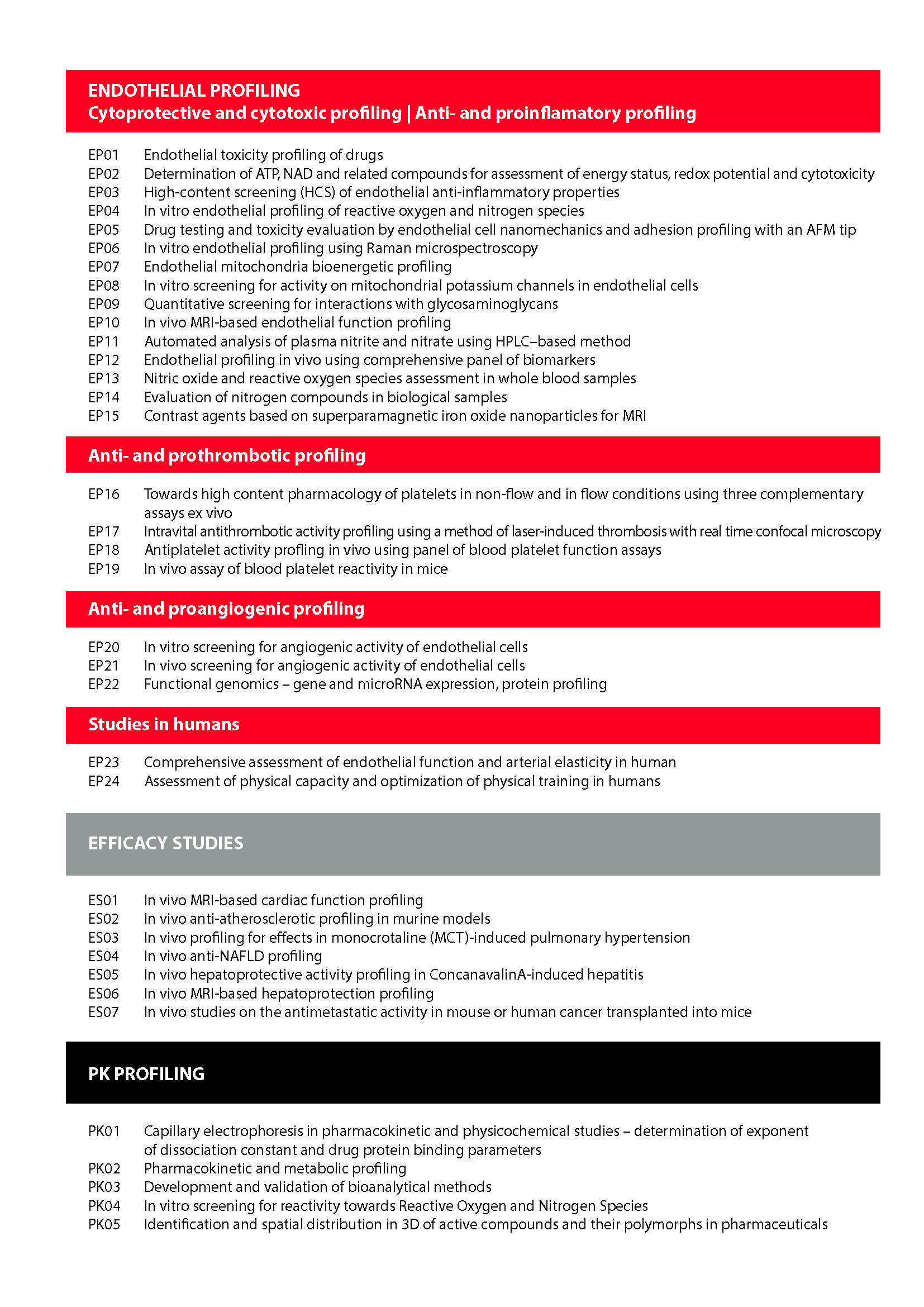Endothelial Profiling
Cytoprotective and cytotoxic profiling | Anti- and proinflamatory profiling
Using high-content screening approach we can analyze for example cytotoxicity, genotoxicity, oxidant stress, fospholipidosis [EP01], effects of compounds on mitochondrial bioenergetics [EP07-08], ATP concentration [EP02], cell shape and cytoskeleton [EP05], and angiogenesis [EP20-22]. Using high contents screening phenotypic analysis we are able to evaluate effects of compounds on early signs of endothelial cells inflammation, including adhesion molecules expression, proinflammatory cytokines generation and monocytes/leukocyte adhesion in flow/non-flow conditions [EP03], changes in bioenergetics [EP07], ATP concentration [EP02], nanomechanics [EP05], biochemical content [EP06], nitric oxide production and ROS production [EP04,]. as well as other endothelial biomarkers [EP12]. Compounds interactions with glycosaminoglicans glycosaminoglicans can be also assessed [EP09]. Finally, panel of assays in vitro, can be supplemented by in vivo studies based on originally developed methodology to assess endothelial function and multiple other end-points [EP10-15]. Studies in humans are also envisaged [EP23-24]
Anti- and prothrombotic profiling
Effects of compounds on the expression of platelets surface markers (eg. CD62P (P-selectin), activated GPIIb/IIIa complex and etc.) using flow cytometry system can be evaluated by platelet activation in vitro and in vivo assays [EP18-19]. Furthermore, ex vivo platelet reactivity assays by assessment of their capacity to dynamic Thromboxane B2 or CD40L generation and their adhesion function in Quartz Crystal Microbalance with Dissipation monitoring system can be studied [EP16]. Under in vivo conditions the endothelium-dependent antithrombotic and/or prothrombotic effects are assessed in experimental models of laser-induced venous thrombosis using intravital confocal microscopy and pulmonary thromboembolism in mice [EP17].
Anti- and proangiogenic profiling
A panel of method is offered to assess effect of compounds on activation or inhibition of angiogenic activities in vitro involving the assessment of morphogenesis, sprouting of capillaries from endothelial spheroids, formation of capillary lumen [EP20] or in the organotypic ex vivo cultures (outgrowth of capillaries from choroid or aortic rings), or finally in murine in vivo models (vascularization of matrigel plugs or growing tumors, revascularization of ischemic skeletal muscles or myocardium, phenotyping or sorting of proangiogenic cell subpopulations) [EP21]. In all models investigation of molecular circuits mediating the observed effects are also possible [EP22].
Efficacy studies
We offer a wide range of efficacy studies in vivo in models of heart failure, atherosclerosis, pulmonary hypertension, NAFLD, hepatitis, cancer and cancer metastasis with comprehensive assessment of multiple end-points including in vivo imaging [ES01-07].
PK profiling
We offer the concise methodology for the effective screening of novel compounds in terms of their physicochemical parameters [PK01], pharmacokinetic assessment of ADME properties in the aspect of bioavailability, percent of binding and absorption rate, metabolite profiling in order to metabolite identification, determination of CYP450 activity and routes of compounds elimination in in vitro, in vivo and ex vivo conditions [PK02-03]. The scope of the offer includes also the comprehensive evaluation of reactivity of compounds with reactive oxygen species, as well as identification of the reactive metabolites that may be useful to assess the mechanism of action, to predict adverse events and compounds bioactivation [PK04]. In terms of drug formulation, the offer proposed methodology for assessment of chemical composition of tablets and pharmaceuticals using Raman imaging [PK05].
More information: services@jcet.eu
Oferta została opracowana w związku z realizacją projektu pt. „Śródbłonek naczyniowy w chorobach cywilizacyjnych: od badań poznawczych do oferty innowacyjnego leku o działaniu śródbłonkowym” współfinansowanego z Europejskiego Funduszu Rozwoju Regionalnego, Program Operacyjny – Innowacyjna Gospodarka, Działanie 1.1.2.

